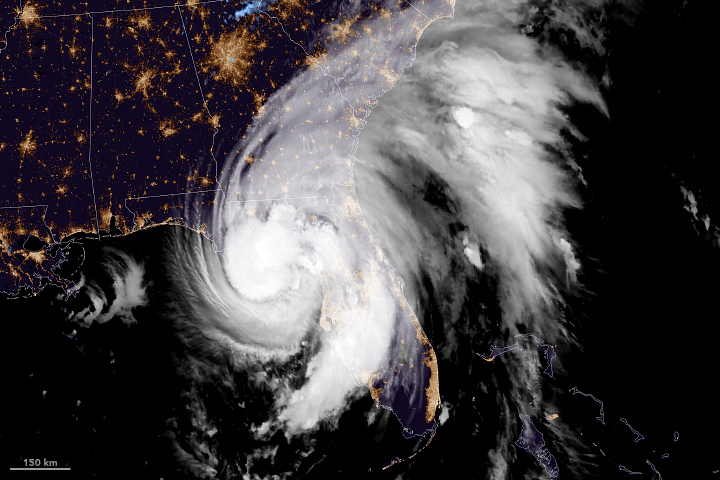Displaying items by tag: hurricane climate change
A climate scientist explains why Debby did us so dirty
 Hurricane Debby made landfall near the town of Steinhatchee, Florida, at 7 a.m. Aug. 5, 2024, as a Category 1 storm. As it moved northeast, the storm stalled over the U.S. Southeast and delivered torrential rainfall. Some areas of South Carolina and Georgia recorded more than 20 inches of rain as the storm crawled northeast toward a second landfall (this time as a strong tropical storm) near Myrtle Beach, S.C. NOAA
Hurricane Debby made landfall near the town of Steinhatchee, Florida, at 7 a.m. Aug. 5, 2024, as a Category 1 storm. As it moved northeast, the storm stalled over the U.S. Southeast and delivered torrential rainfall. Some areas of South Carolina and Georgia recorded more than 20 inches of rain as the storm crawled northeast toward a second landfall (this time as a strong tropical storm) near Myrtle Beach, S.C. NOAA
A warming climate means more water vapor, which means bigger and wetter tropical storms
(This story was originally published by The Conversation.)
Tropical Storm Debby was moving so slowly, Olympians could have outrun it as it moved across the Southeast in early August 2024. That gave its rainfall time to deluge cities and farms over large parts of Florida, Georgia and the Carolinas. More than a foot of rain had fallen in some areas by early Aug. 7, with more days of rain forecast there and into the Northeast.
Mathew Barlow, a climate scientist at UMass Lowell, explains how storms like Debby pick up so much moisture, what can cause them to slow or stall and what climate change has to do with it.
What causes hurricanes to stall?
Hurricanes are steered by the weather systems they interact with, including other storms moving across the U.S. and the Bermuda High over the Atlantic Ocean.
A hurricane may be moving slowly because there are no weather systems close enough to pull the hurricane along, or there might be a high-pressure system to the north of the hurricane that blocks its forward movement. In this case, a high-pressure system over the western U.S. was slowing Debby’s forward progress and the Bermuda High — which is a large, clockwise circulation of winds that generally runs up the East Coast — wasn’t close enough to be a factor.
That’s similar to what happened with the remnants of Hurricane Harvey in 2017, one of the best-known examples of a stalled hurricane. High pressure over the U.S. blocked its forward movement, allowing it to drop more than 50 inches of rain on parts of Texas.
Slower-moving storms have longer to rain over the same area, and that can dramatically increase the risk of flooding, as the Southeast is experiencing with Debby.
- tropical storm debby
- tropical storms climate change
- how is climate change affecting the south
- georgia flooding
- south carolina flooding
- north carolina flooding
- debby rain
- how much rain debby
- hurricane forecasting
- mathew barlow
- how warm is the ocean
- is ocean warmer than normal
- hurricane climate change
- umass lowell climate science
Brutal Hurricane Ian was just one of budding global weather emergencies at the time
 Catastrophic damage to the Sanibel Island Causeway is shown in this NOAA overflight after Hurricane Ian absolutely demolished most of Fort Myers Beach, Florida.
Catastrophic damage to the Sanibel Island Causeway is shown in this NOAA overflight after Hurricane Ian absolutely demolished most of Fort Myers Beach, Florida.
Evidence mounts that climate change is creating monster storms as death toll climbs in Ian’s wake
This story was originally published by The Conversation.
FORT MYERS BEACH — When Hurricane Ian hit Florida and killed at least 100 people, it was one of the United States’s most powerful hurricanes on record, and it followed a two-week string of massive, devastating storms around the world.
A few days earlier in the Philippines, Typhoon Noru gave new meaning to rapid intensification when it blew up from a tropical storm with 50 mph winds to a Category 5 monster with 155 mph winds the next day. Hurricane Fiona flooded Puerto Rico, then became Canada’s most intense storm on record. Typhoon Merbok gained strength over a warm Pacific Ocean and tore up over 1,000 miles of the Alaska coast.
- hurricane ian
- hurricane climate change
- climate change
- fort myers beach
- does climate change make hurricane worse?
- typhoon noru
- typhoon merbok
- alaska typhoon
- the conversation
- matthew barlow
- suzana camargo
- storm surge
- hurricane research
- climate change research
- monster storm
- attribution study
- storm severity
- storm frequency
- wind speed
- rain intensity
- storm intensification
- probability
- theory
- historical data